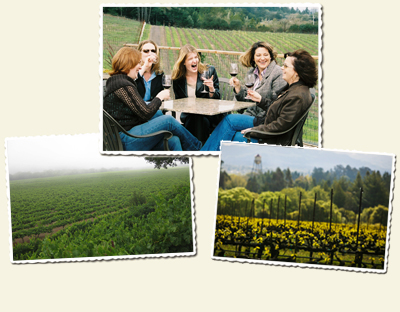Swirl, Sniff, Taste
Tasting Tips
Remember - There are no right or wrong descriptions of how a wine tastes or smells. Everyone's palate is as unique and different as each individual. Wine tasting is not the same as drinking it. Below are some tips to help you experience the true flavor of a wine. Take your time, pay attention to your senses of sight, smell, touch, as well as taste.
The Basics:
Start with a clear wine glass. The rim of the glass should bend inwards to help funnel aromas to the nose, and allow you to swirl without spilling.
Holding a wine glass: There is a right way and a wrong way to hold a wine glass, and it does make a difference. Never hold the glass by its bowl, only by its stem since the heat of your hand will quickly warm the liquid.
In a tasting room a host will offer to pour wines beginning with the lightest white wines first and progress to the heaviest red wines. This will help keep your taste buds more sensitive so you can better appreciate each wine in the series. A sip of water between wines can also help preserve your palate.
Sight:
The best way to observe the color of the wine is to slightly tilt your glass and hold it up to the light or look at it against a white or pale background.
Is the wine clear or cloudy? The color will vary according to what wine it is.
Red Wines: Red wines vary greatly in color. A young red wine is typically a bright-raspberry color. You will see hints of reddish-brown around the edges. An older red wine might be mahogany to brick-like in color. As red wine ages, the wine tends to have a brick-like color.
White Wines: White wines range from pale green to yellow to deep golden brown and become more golden as they age.
Swirl:
While firmly holding the stem of the wine glass, gently swirl the glass in tiny circles on a flat surface for 10 to 20 seconds allowing oxygen to penetrate the wine. The purpose of swirling wine in a glass is to aerate the wine and release vapors, evaporating from the sides of the glass, for you to smell. As the wine coats the sides of the glass, it releases its bouquet.
Observe the streaks of wine (legs) as they roll down the side of the glass. The legs can help you determine the body of the wine.
Smell or Sniff:
Tip the glass up and stick your nose in it and inhale. Some tasters claim that you can get more aroma by holding your nose an inch or so above the glass after swirling. They think you catch more than you would if you put your nose all the way into the glass. Did you know that 80% of our sense of taste is actually in our nose? What do you smell? At the top of the glass, the smells are more floral and fruity; deeper in the glass, they are richer. Try to detect the full range of scents from berry to floral to spicy to woody ... and so on. Consider intensity and appeal.
Sip and Taste:
At last…the final step. Sip the wine, letting the wine spread across the tongue from front to back and side to side before swallowing.
If you feel comfortable doing so, carefully slurp some air through puckered lips. This slurping of air (aerating) will help to release flavor and aromas. Assessing the wine by taste should confirm the conclusions drawn from the appearance assessment and the smell assessment.
The tip of the tongue detects sweetness
The inner sides of the tongue detect sourness and/or acidity
The outer sides of the tongue detect saltiness
The back of the tongue detects bitterness and/or alcohol
At this point you can either spit it out (especially if you are tasting several wines) or simply drink it, but be sure to experience the aftertaste (the finish). Professional wine tasters will not swallow the wine, but immediately spit it out (you will see buckets for this purpose). You can also dump excess wine into the buckets provided at the tasting bar – this is not insulting to your winery host.
Happy Tasting...
